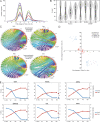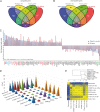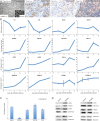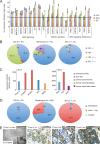BMP Inhibition in Seminomas Initiates Acquisition of Pluripotency via NODAL Signaling Resulting in Reprogramming to an Embryonal Carcinoma
- PMID: 26226633
- PMCID: PMC4520454
- DOI: 10.1371/journal.pgen.1005415
BMP Inhibition in Seminomas Initiates Acquisition of Pluripotency via NODAL Signaling Resulting in Reprogramming to an Embryonal Carcinoma
Abstract
Type II germ cell cancers (GCC) can be subdivided into seminomas and non-seminomas. Seminomas are similar to carcinoma in situ (CIS) cells, the common precursor of type II GCCs, with regard to epigenetics and expression, while embryonal carcinomas (EC) are totipotent and differentiate into teratomas, yolk-sac tumors and choriocarcinomas. GCCs can present as seminomas with a non-seminoma component, raising the question if a CIS gives rise to seminomas and ECs at the same time or whether seminomas can be reprogrammed to ECs. In this study, we utilized the seminoma cell line TCam-2 that acquires an EC-like status after xenografting into the murine flank as a model for a seminoma to EC transition and screened for factors initiating and driving this process. Analysis of expression and DNA methylation dynamics during transition of TCam-2 revealed that many pluripotency- and reprogramming-associated genes were upregulated while seminoma-markers were downregulated. Changes in expression level of 53 genes inversely correlated to changes in DNA methylation. Interestingly, after xenotransplantation 6 genes (GDF3, NODAL, DNMT3B, DPPA3, GAL, AK3L1) were rapidly induced, followed by demethylation of their genomic loci, suggesting that these 6 genes are poised for expression driving the reprogramming. We demonstrate that inhibition of BMP signaling is the initial event in reprogramming, resulting in activation of the pluripotency-associated genes and NODAL signaling. We propose that reprogramming of seminomas to ECs is a multi-step process. Initially, the microenvironment causes inhibition of BMP signaling, leading to induction of NODAL signaling. During a maturation phase, a fast acting NODAL loop stimulates its own activity and temporarily inhibits BMP signaling. During the stabilization phase, a slow acting NODAL loop, involving WNTs re-establishes BMP signaling and the pluripotency circuitry. In parallel, DNMT3B-driven de novo methylation silences seminoma-associated genes and epigenetically fixes the EC state.
Conflict of interest statement
The authors have declared that no competing interests exist.
Figures






Similar articles
-
SOX2 is essential for in vivo reprogramming of seminoma-like TCam-2 cells to an embryonal carcinoma-like fate.Oncotarget. 2016 Jul 26;7(30):47095-47110. doi: 10.18632/oncotarget.9903. Oncotarget. 2016. PMID: 27283990 Free PMC article.
-
The plasticity of germ cell cancers and its dependence on the cellular microenvironment.J Cell Mol Med. 2017 Aug;21(8):1463-1467. doi: 10.1111/jcmm.13082. Epub 2017 Feb 28. J Cell Mol Med. 2017. PMID: 28244655 Free PMC article. Review.
-
Unique and redundant roles of SOX2 and SOX17 in regulating the germ cell tumor fate.Int J Cancer. 2020 Mar 15;146(6):1592-1605. doi: 10.1002/ijc.32714. Epub 2019 Nov 1. Int J Cancer. 2020. PMID: 31583686
-
TCam-2 Cells Deficient for SOX2 and FOXA2 Are Blocked in Differentiation and Maintain a Seminoma-Like Cell Fate In Vivo.Cancers (Basel). 2019 May 25;11(5):728. doi: 10.3390/cancers11050728. Cancers (Basel). 2019. PMID: 31130628 Free PMC article.
-
Pathogenesis of testicular germ cell tumours.Rev Reprod. 1999 May;4(2):90-100. doi: 10.1530/ror.0.0040090. Rev Reprod. 1999. PMID: 10357096 Review.
Cited by
-
The cancer/testis-antigen PRAME supports the pluripotency network and represses somatic and germ cell differentiation programs in seminomas.Br J Cancer. 2016 Aug 9;115(4):454-64. doi: 10.1038/bjc.2016.187. Epub 2016 Jul 21. Br J Cancer. 2016. PMID: 27441500 Free PMC article.
-
On the origin of germ cell neoplasia in situ: Dedifferentiation of human adult Sertoli cells in cross talk with seminoma cells in vitro.Neoplasia. 2021 Jul;23(7):731-742. doi: 10.1016/j.neo.2021.05.008. Epub 2021 Jun 18. Neoplasia. 2021. PMID: 34153645 Free PMC article.
-
Activin and BMP Signalling in Human Testicular Cancer Cell Lines, and a Role for the Nucleocytoplasmic Transport Protein Importin-5 in Their Crosstalk.Cells. 2023 Mar 24;12(7):1000. doi: 10.3390/cells12071000. Cells. 2023. PMID: 37048077 Free PMC article.
-
Meta-Analysis of Gene Expressions in Testicular Germ Cell Tumor Histologies.Int J Mol Sci. 2020 Jun 24;21(12):4487. doi: 10.3390/ijms21124487. Int J Mol Sci. 2020. PMID: 32599785 Free PMC article.
-
A Coculture Model Mimicking the Tumor Microenvironment Unveils Mutual Interactions between Immune Cell Subtypes and the Human Seminoma Cell Line TCam-2.Cells. 2022 Mar 4;11(5):885. doi: 10.3390/cells11050885. Cells. 2022. PMID: 35269507 Free PMC article.
References
-
- Oosterhuis JW, Looijenga LH. Testicular germ-cell tumours in a broader perspective. Nat Rev Cancer. 2005;5: 210–222. - PubMed
-
- Gillis AJM, Stoop H, Biermann K, van Gurp RJHLM, Swartzman E, Cribbes S, et al. Expression and interdependencies of pluripotency factors LIN28, OCT3/4, NANOG and SOX2 in human testicular germ cells and tumours of the testis. International Journal of Andrology. 2011;34: e160–74. 10.1111/j.1365-2605.2011.01148.x - DOI - PubMed
-
- Biermann K, Heukamp LC, Steger K, Zhou H, Franke FE, Sonnack V, et al. Genome-wide expression profiling reveals new insights into pathogenesis and progression of testicular germ cell tumors. Cancer Genomics Proteomics. 2007;4: 359–367. - PubMed
MeSH terms
Substances
Associated data
- Actions
- Actions
Grants and funding
LinkOut - more resources
Full Text Sources
Other Literature Sources
Molecular Biology Databases

